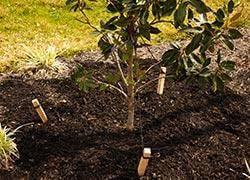Fall Is a Good Time to Plant Trees and Shrubs
Fall is one of the best times to plant trees and shrubs in your landscape. Fall planting provides the plant with the opportunity to put its energy into root growth now and in the early spring, before it has to concentrate on producing leaves. Roots grow well in cooler soils, and the plant also doesn’t need as much water once the leaves drop.
Granted, there is usually more plant selection in the spring, but with a simple search through local nurseries and catalog companies, you can usually find something that will fill your landscaping needs in the fall. At this time of year, you might even find good plant stock on sale.
Woody plants are sold in three different ways: container-grown, balled-and-burlapped and bare-root. Each has its own advantages and planting requirements.
Container-grown has the advantage of having the entire root system intact. They are often less expensive to ship, because they are grown in a light, artificial soil. If you’re not ready to plant just yet, they keep well in their container, as long as you water them regularly.
The disadvantage is that, once planted, their roots often take a while to break away from their planting medium into the surrounding soil. And because that medium dries out faster, watering is key to their survival.
Balled-and-burlapped trees and shrubs are usually much larger than container-grown plants. When the nursery digs the tree for sale, they cut the root ball and wrap it in burlap. You’ll need to keep these in a sheltered place outdoors until you plant them, and the sooner you plant them the less stressed the tree will be. Because of their heavy weight, it often takes more than one person to move the tree and lower it gently into the hole. Dropping the soil ball into the hole will crack and break the roots.
Fruit trees and hedges are commonly sold as bare-root plants. Bare-root plants are normally kept in cold storage until they are sold. It’s important to plant these promptly before they break dormancy. Because they are light, they are the most economical to ship, but the disadvantage is that they suffer a great deal of root loss when they are dug and the soil removed from their roots. Bare-root trees and shrubs have a higher survival rate if they’re planted in the spring.
When choosing your site, consider not only where the plant will look good, but also where it will grow successfully. Keep in mind the mature size of the plant. It may look lonely planted so far from your house when it’s young, but at maturity, you will be grateful that its roots aren’t cracking your foundation or the branches aren’t interfering with gutters, windows or overhead utility lines.
You’ll want a site where the soil is deep, fertile and well-drained. Planting trees in compacted soils with a high clay content can result in surface roots, stunted growth and problems with diseases and insects.
Hand-digging the hole with a shovel is the best method. The roots must be able to penetrate all sides of the planting hole, so make sure that the sides of the hole are roughed up and not glazed or slick from using an auger or digging the hole while the soil is wet.
Remove all packing material from the root system and cut away all nursery tags and twine or wire. Then spread out or pull apart the roots. In container-grown plants, make vertical cuts with a sharp knife 1-inch deep at four to six locations around the root ball. This action can prevent roots from continuing to circle, which can girdle the tree later in its life.
Plant the roots at the same depth they were previously grown, which will provide them with enough oxygen to take up water and minerals from the soil.
Fill the hole halfway with soil and water thoroughly. Fill the remainder of the hole with more topsoil and water the plant again. Generally, the best soil to use is the same soil the plant came from. Soil amendments such as peat moss and pine bark are expensive and do little to help the plant establish itself in the new spot.
Most newly installed trees and shrubs that die in the first two years die of improper watering; too much or not enough. If it doesn’t rain at least 0.5 to 1-inch per week, water once a week in the cooler months of spring and fall and twice a week during the hot, dry months. Watering during winter is generally not necessary for deciduous plants. Supplemental watering may need to continue into the second growing season. When you water, soak the root zone and do not water again until the root zone begins to dry. Proper watering during the time it takes to become re-established will help ensure your new tree or shrub will flourish for many years to come.
For more information, contact the Butler County Extension Office of the University of Kentucky Cooperative Extension Service at 102 Parkway Lane, Morgantown or by calling 270-526-3767.
Educational programs of the Cooperative Extension Service serve all people regardless of economic or social status and will not discriminate on the basis of race, color, ethnic origin, national origin, creed, religion, political belief, sex, sexual orientation, gender identity, gender expressions, pregnancy, marital status, genetic information, age, veteran status, or physical or mental disability.
By: Greg Drake II, County Extension Agent for Agriculture and Natural Resources



























